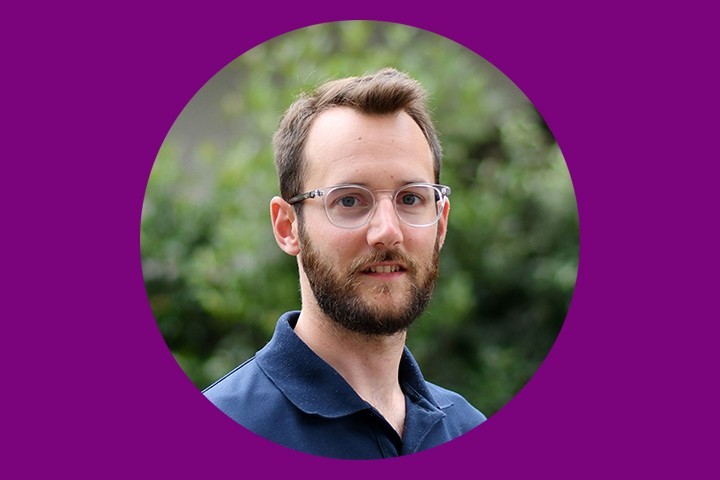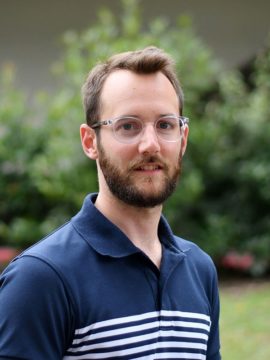
Interview: Matthieu Guémann
 After a thesis defended in December 2019, which he presented in the competition “My thesis in 180s”, Matthieu Guémann is currently a post-doctoral researcher in Aymar de Rugy’s team (Hybrid) at INCIA. Having gone from paramedical to research, he is now on his way to creating a start-up. We met him.
After a thesis defended in December 2019, which he presented in the competition “My thesis in 180s”, Matthieu Guémann is currently a post-doctoral researcher in Aymar de Rugy’s team (Hybrid) at INCIA. Having gone from paramedical to research, he is now on his way to creating a start-up. We met him.
Bordeaux Neurocampus: What is the particularity of your research subject?
Matthieu Guémann: In Aymar de Rugy’s team, we study and work on the problem of upper limb amputees. This concerns a very small population and, unfortunately, too few researchers are interested in it. We are studying more precisely the problems surrounding sensory-motor control, i.e. we are trying to understand the modifications that occur following amputation at the cortical level but also at the peripheral level related to motor control: planning and carrying out gestures. Gestures that were extremely automatic and natural before amputation must be largely relearned. The questions we are trying to answer are what these changes are and how to minimize their impact.
In fact, the brain always has a complete map of the body, and it keeps it in its memory. The loss of a limb will disrupt this structure and the link between action and perception. What the patient sees is therefore no longer necessarily what he or she feels, which can lead to potential pain and phenomena such as phantom limb. In addition to this, the patient has to mourn the loss of an arm and the many lost functions. For unlike a leg, which is mainly useful for balance and locomotion (walking/running), the arm is used for eating, communicating, etc.
Originally, you are a physiotherapist. The connection seems obvious, but what guided you in the research field, and how is your experience useful?
Quite early in my career, I was curious to know about rehabilitation techniques applied to patients to see if there was a better one than another? By talking to my teachers and going to congresses or professional meetings during my studies, I discovered that the scientific method applied in everyday research could help me answer these questions. Therefore, later on, at the same time as my work as a physiotherapist, I enrolled in a Master’s degree in clinical research. My Master 2 internship in a research laboratory in rehabilitation sciences then confirmed my attraction for this kind of career.
My experience as a physiotherapist brings a clinician’s eye in my research and completes, I hope, the vision of the team with profiles coming from movement sciences, « STAPS » (sciences and technics of sports and physical activities)…
My training as a clinician means that in all my reflections, in addition to trying to explain the mechanisms observed by experience, I am driven by the need to respond to clinical problems with the aim of improving the quality of life of patients. This strong link between these two worlds allows me to make the most of my dual background: a good understanding of clinical problems and the use of scientific research methods to respond to them.
We also have highly qualified engineers in computer science or electronics to help us, and they are essential for setting up the experiments. For example, I am working on my project with Christophe Halgand who is a research engineer in scientific computing and a PhD in automation. It’s the combination of all the skills, brought together from complementary points of view, that really makes the team’s richness.
The ultimate goal of the research is to improve the daily lives of patients. What difficulties do amputees encounter?
Today, in France, some prostheses are reimbursed. However, their use requires not very intuitive gestures. For example, we will ask to contract the biceps to open the hand or turn the wrist: it is a new motor scheme to be integrated. This requires training, like when you learn a new sporting gesture. So it involves a lot of rehabilitation sessions and very often the benefit in relation to the time invested is not very important. The result is that, unfortunately, many patients give up after one or two years of work and then learn to manage differently. There is still a gap between research, where you try to get people to do a movement, and real life, which is sometimes a little harder than life in the laboratory.
Like Corey Butler from IINS, you were the 2019 winner of the i-PhD innovation competition. Can you tell us more about that?
Indeed, I was a winner with the MyoTact project, which I am carrying with Christophe Halgand and which is based on sensory substitution. As its name suggests, it is a technology that aims to compensate for a handicap by using an electronic and computer device to substitute one sense for another. MyoTact is therefore intended to improve learning to control upper limb myoelectric prostheses… and reduce the drop-out rate. The device could eventually be used for other applications such as neurological pathologies. Winning this competition has opened doors in the world of entrepreneurship to develop a network, to be advised. In particular, we are supported by the SATT Aquitaine Science Transfert. We also benefit from the RISE programme, a support programme for the creation of start-ups by CNRS Innovation, the CNRS’ national valorisation subsidiary.
Finally, this project is also supported by the Agence de l’Innovation de Défense (AID), which is a structure of the Direction Générale de l’Armement (DGA) and which financed my thesis and continues to finance my post-doc (I would like to take this opportunity to thank them). Indeed, many patients with upper limb amputations are military personnel, which makes our research an important issue for the reintegration of soldiers into civilian life or the army.
You have an atypical background. Do you have one last thing to add for the students or younger people who read us?
Today it is possible to take extremely diverse and often crossed paths to access certain professions. There are more and more gateways, and we shouldn’t worry about the route or the starting point. The main thing is to be motivated by a topic and then to find the right group to work with, the right research team or the right department!
Propos recueillis par Nathan Florent
More details
Programme AST : https://www.ast-innovations.com/
CNRS innovation : https://www.cnrsinnovation.com/
AID : https://www.defense.gouv.fr/aid
Last update 15/07/20
